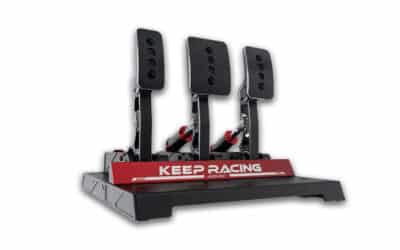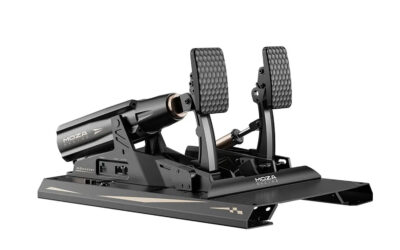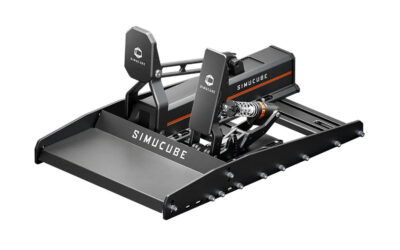Simlab XP1
Benefits
- Highly adjustable crankset
- Excellent manufacturing quality
- 200 kg Load Cell
Disadvantages
- No haptic feedback (vibration) for ABS
- No support or footrest as standard
Our rating: 9.6/10
The company Simlab is a little young in the sim-racing market. It was created in 2015 for a simple reason: its founder couldn’t find a sim-racing cockpit that was both good quality and affordable. The options at the time, and this is still the case for some brands, were expensive for the quality ones, and the others were aimed at an amateur audience playing Forza Horizon and not Assetto Corsa.
Simlab’s range includes mainly cockpits, but also sim-racing peripherals such as pedals, handbrakes, dashboards and other racing accessories for customizing your setup.
Speaking of pedals, the XP1 is the Dutch brand’s answer to the tenors of the industry. Where most competitors, at least in this segment, offer Load Cell cranksets with 100 kg of force, the XP1 doubles this value, and can even be compared to hydraulic devices in some cases. In what follows, we take a closer look at how the XP1 measures up against the competition.
Main features and technical specifications of the crankset
- Full aluminum structure
- Available in 2 versions: 2 or 3 pedals
- PC and RaceDirector compatible
- Adjustable pedals on all points
- 200 kg Load Cell
- 16-bit pedal resolution
- Control box for easy management of wiring and PC connection
- Supplied with various elastomers and springs for both brake and gas pedal.
- Gas pedal and clutch pedal with magnetic sensor
Design
The XP1’s design is simply stunning, screaming premium from first visual contact. It’s not only beautiful, but minimalist too, indicating a perfect match with any setup.
The pedals are black, part of a gray structure. The front features a small knob for pedal adjustment. At the rear, the resistance system takes its place, with elements in blue as well, and gold for the LC. Quite simply, as far as I’m concerned, this is one of the most beautiful cranksets currently available on the market.
Customized assembly
The first disappointment is the assembly of the XP1. All you get in the box are the 2 or 3 pedals, depending on your choice at the time of purchase. There’s no plate, bracket or even footrest supplied as standard with the XP1. You’ll have to pay cash to get these, and I think it’s cheap of Simlab to have taken this route, especially as the XP1 isn’t exactly budget friendly, and the adjustable stand costs less than €90.
Each pedal is individual, and you’ll need a modern chassis that can accommodate this. Assembly is relatively straightforward: you have 2 rails on each side of the pedals to accommodate the screws and bolts, and to enable mounting on a chassis. All the hardware is in the XP1 box, and you even get ” T “for aluminum profile cockpits.
Manufacturing and finishing
The XP1 is based on an all-aluminum structure, with metal components too. The build quality is simply top-notch, worthy of other Simlab products. This is evident as soon as you pick up one of the pedals when you first unpack it.
As far as the finish is concerned, it’s obvious: premium and premium again. All pedal parts are machined to perfection, with no blemishes, burrs or anything else. It’s just perfect, from the pedal plate, to the adjustment knobs, to the assembly of the product’s components. However, concessions had to be made, and it showed on the XP1’s control box. It’s the kind of really cheap plastic that you’ll be afraid of squeezing a little too hard between your hands, or dropping. Fortunately, this part is designed to be installed at the rear of the cockpit and never show its face again.
Bottom bracket settings
So, the settings available on the XP1. For some, you’ll need tools. And for most, there’s no need. On this crankset, you can adjust pedal height and angle, pedal pad angle, travel stop, spring hardness, elastomer hardness, spring pre-loading using the thumbwheel, and overall pedal hardness.
That was for the physical settings. Of course, Simlab offers software settings via RaceDirectorXP1 connected to a PC. To put it simply: this crankset is highly adjustable, whether for the gas pedal, brake or clutch pedals.
Sensations during play
Once the XP1 is installed on your cockpit, it’s time to take it out for a spin. First impressions are excellent, I must say, with a very smooth throttle pedal under your right foot. The latter is adjustable to suit different sim-racing competitions. What’s more, the spring is swappable, so you can adjust the resistance.
The brake pedal is a completely different story. You have the same settings as the accelerator pedal, plus the option of swapping the elastomer and spring to modify the feel under your right foot.
The Load Cell is a two-stage system, as found on most products in this segment. The spring (first stage) takes care of around 70-80% of the braking power, with swappable spring of course, and the elastomer takes care of the remaining percentages to give you a rock-solid feel. In terms of feel, the XP1 is pure sim-racing bliss, especially for its brake pedal and 200 kg LC. You’ll need just a few laps of the track to get the hang of braking with the XP1, even though it doesn’t have haptic feedback for ABS, which is a bit of a shame I must admit.
I didn’t notice any dead zone at all on the initial brake stroke, and anyway, RaceDirector allows you to adjust all aspects of this crankset.
Compatibility
As with all Simlab peripherals, the XP1 is PC-compatible only. The small box supplied with the pedalboard allows connection via USB to any computer running Windows.
And for sim-racing titles, you’ll have native compatibility with the industry’s tenors, namely AC, ACC, iRacing, AM2, RF2etc. What’s more, RaceDirector lets you set up this device to work with more or less anything to do with sim-racing.
Value for money
You have 4 options to choose from for the XP1: the 2-pedal variant for €499, the 3-pedal for €649, the 3-pedal Black Edition for €649, and the clutch pedal alone for €199. The accessory part is also optional, to keep the price-performance ratio up, I presume.
Compared to the competition, the XP1’s price is very aggressive, giving it excellent value for money. Of course, if you take it in a 3-pedal configuration with the baseplate, the bill will come to €740, but that’s still a very good price for a top-quality product, and a high-performance one at that. Don’t forget that a Fanatec ClubSport Pedals V3 Inverted costs €600.
My verdict
I’ve really enjoyed using this XP1 from Simlab. It’s beautiful, useful, powerful, adjustable and, above all, attractively priced compared to the competition. If you already have a good Load Cell pedalboard on your PC, the XP1 won’t change your mind and make you fall in love with Simlab’s offering. It’s still a premium sim-racing device like all the others, but it doesn’t revolutionize its segment either. And if you’re a console racer, it’s not even worth considering, as it’s not compatible with Xbox and Playstation platforms. Fanatec remains the undisputed master of this segment.
However, if you’re considering a Load Cell pedalboard for a PC setup, the XP1 is definitely worth a look. You’ll get excellent pedal settings, 200 kg of Load Cell, build quality worthy of luxury German cars and a contained price. Frankly, for first-time buyers, the XP1 ticks all the boxes of a good LC pedalboard.











0 Comments